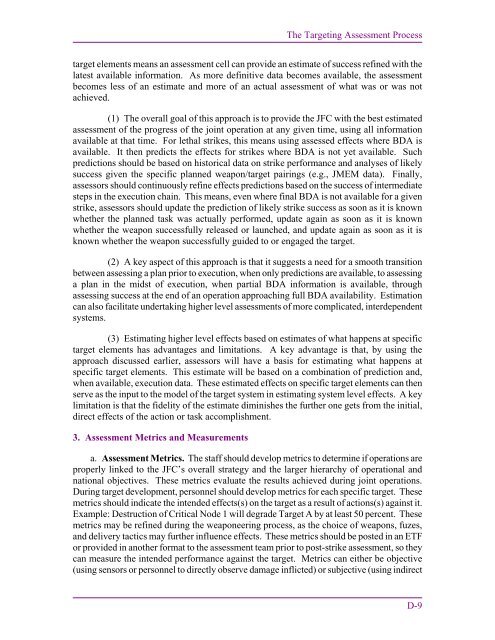Joint Targeting
1F87id9
1F87id9
You also want an ePaper? Increase the reach of your titles
YUMPU automatically turns print PDFs into web optimized ePapers that Google loves.
The <strong>Targeting</strong> Assessment Process<br />
target elements means an assessment cell can provide an estimate of success refined with the<br />
latest available information. As more definitive data becomes available, the assessment<br />
becomes less of an estimate and more of an actual assessment of what was or was not<br />
achieved.<br />
(1) The overall goal of this approach is to provide the JFC with the best estimated<br />
assessment of the progress of the joint operation at any given time, using all information<br />
available at that time. For lethal strikes, this means using assessed effects where BDA is<br />
available. It then predicts the effects for strikes where BDA is not yet available. Such<br />
predictions should be based on historical data on strike performance and analyses of likely<br />
success given the specific planned weapon/target pairings (e.g., JMEM data). Finally,<br />
assessors should continuously refine effects predictions based on the success of intermediate<br />
steps in the execution chain. This means, even where final BDA is not available for a given<br />
strike, assessors should update the prediction of likely strike success as soon as it is known<br />
whether the planned task was actually performed, update again as soon as it is known<br />
whether the weapon successfully released or launched, and update again as soon as it is<br />
known whether the weapon successfully guided to or engaged the target.<br />
(2) A key aspect of this approach is that it suggests a need for a smooth transition<br />
between assessing a plan prior to execution, when only predictions are available, to assessing<br />
a plan in the midst of execution, when partial BDA information is available, through<br />
assessing success at the end of an operation approaching full BDA availability. Estimation<br />
can also facilitate undertaking higher level assessments of more complicated, interdependent<br />
systems.<br />
(3) Estimating higher level effects based on estimates of what happens at specific<br />
target elements has advantages and limitations. A key advantage is that, by using the<br />
approach discussed earlier, assessors will have a basis for estimating what happens at<br />
specific target elements. This estimate will be based on a combination of prediction and,<br />
when available, execution data. These estimated effects on specific target elements can then<br />
serve as the input to the model of the target system in estimating system level effects. A key<br />
limitation is that the fidelity of the estimate diminishes the further one gets from the initial,<br />
direct effects of the action or task accomplishment.<br />
3. Assessment Metrics and Measurements<br />
a. Assessment Metrics. The staff should develop metrics to determine if operations are<br />
properly linked to the JFC’s overall strategy and the larger hierarchy of operational and<br />
national objectives. These metrics evaluate the results achieved during joint operations.<br />
During target development, personnel should develop metrics for each specific target. These<br />
metrics should indicate the intended effects(s) on the target as a result of actions(s) against it.<br />
Example: Destruction of Critical Node 1 will degrade Target A by at least 50 percent. These<br />
metrics may be refined during the weaponeering process, as the choice of weapons, fuzes,<br />
and delivery tactics may further influence effects. These metrics should be posted in an ETF<br />
or provided in another format to the assessment team prior to post-strike assessment, so they<br />
can measure the intended performance against the target. Metrics can either be objective<br />
(using sensors or personnel to directly observe damage inflicted) or subjective (using indirect<br />
D-9


